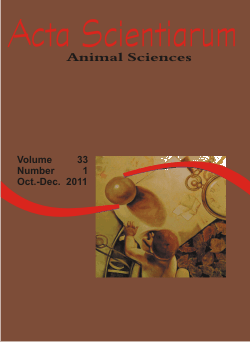<b>Propolis-based product (LLOS) in the diet of feedlot bulls: animal behavior and blood responses</b> - doi: 10.4025/actascianimsci.v33i1.10671
Keywords:
animal behavior, feedlot, propolis, blood
Abstract
The behavior and blood responses of feedlot animals fed diets containing a propolis-based product (LLOS) were evaluated. The treatments were control (CON) and two propolis-based products (LLOSC1 and LLOSC1+). The measured behaviors were: eating (EAT), drinking water (DRI), walking (WAL), ruminating on standing (RUST), lying rumination (LYR), standing (STA) and lying (LYI). More time was spent in the morning (MO) and afternoon (AFT) for EAT, DRI, WAL, RUST and STA and in the evening (EV) and overnight (ON) for RUST and LYI. Animals on Side 1 of the feedlot spent more time walking in MO and EV, with no differences for ON, and more time STA for animals in Side 1 in MO, AFT and ON, and equal in EV. Cortisol, glucose and urea were not affected by treatments. No effects of treatments were observed for hemoglobin, hematocrit, MCV, MCH, MCHC and IgG, and the content of erythrocyte was higher in LLOSC1 and LLOSC1+ than in the CON. Animals receiving LLOSC1+ showed higher values of leukocytes, segments, lymphocytes, and monocytes than CON. The propolis-based diet did not affect biochemical, erythrocyte and immune parameters, but increased leukocytes. The position of the feedlot was important in the behavior of animals.Downloads
Download data is not yet available.
Published
2011-02-03
How to Cite
Faria, L. A. N., Barbosa, O. R., Zeoula, L. M., Aguiar, S. C. de, Prado, R. M. do, & Bertolini, D. A. (2011). <b>Propolis-based product (LLOS) in the diet of feedlot bulls: animal behavior and blood responses</b> - doi: 10.4025/actascianimsci.v33i1.10671. Acta Scientiarum. Animal Sciences, 33(1), 79-85. https://doi.org/10.4025/actascianimsci.v33i1.10671
Issue
Section
Animal Production
DECLARATION OF ORIGINALITY AND COPYRIGHTS
- I Declare that current article is original and has not been submitted for publication, in part or in whole, to any other national or international journal.
The copyrights belong exclusively to the authors. Published content is licensed under Creative Commons Attribution 4.0 (CC BY 4.0) guidelines, which allows sharing (copy and distribution of the material in any medium or format) and adaptation (remix, transform, and build upon the material) for any purpose, even commercially, under the terms of attribution.
Read this link for further information on how to use CC BY 4.0 properly.
0.9
2019CiteScore
29th percentile
Powered by 








































